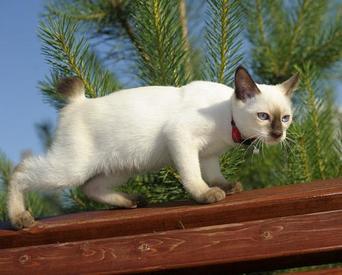
The Mekong Bobtail originates from...
Believed by some to be descended from shorthaired Siamese, the Mekong Bobtail derives its name from the Mekong River in Thailand, its supposed place of origin. It is commonly thought that this cat was used to guard the treasury and palace against vandals and thieves, while accompanying female figures of royalty on their walks of the grounds. The Mekong Bobtail also has a connection with Russia, where it is thought the cat was first recognised as a distinct breed. Considered a royal cat, the Mekong Bobtail was often gifted to visiting diplomats and nobles during the 19th century, including Nicholas II, Tsar of Russia.
The Mekong Bobtail is characterised by...
Comparable to the Siamese in composition and appearance, the Mekong Bobtail possesses a slender and athletic body structure, with long legs, medium-size ears and blue ovular eyes. The hind legs are generally a bit longer than the front legs, which give a hunched over impression. The coat is close-lying and easy to maintain, and only sheds a little bit. The basic principle for coat patterning is that all colours are permissible, including all pointing without white.
The average Mekong Bobtail...
As with the Siamese, the Mekong Bobtail is generally a highly inquisitive and intelligent breed that doesn’t miss a trick! Its amiable and easy temperament makes it a great companion cat, while its playful, spirited and humorous streak is a guaranteed pleaser. If you are looking for a quiet, docile cat, the Mekong Bobtail is probably not the best cat for you. Communicating loudly when it wants your attention and full of energy and life, the Mekong needs plenty of company and a variety of interactive toys and playthings in order to remain happy and stimulated at home. Typically, an adult Mekong Bobtail will weigh 8-10 pounds, with a life expectancy of 15-18 years.
Weaknesses...
Although the Mekong Bobtail is believed to be a cat of good health and resilience, there is evidence to suggest that all breeds deriving from the Siamese are prone to higher rates of mortality than other feline breeds. Common health complaints identified in these Siamese descendents include gastrointestinal conditions, neoplasms and mammary tumours, as well as several eye disorders.








I don't "own" a Mekong! As no one owns a cat specially a Mekong! But, I grew up with one in Egypt. He was the most energetic and naughty of cats! When I went past my bed he would be hiding there underneath getting ready to pounce. He attacked my feet with claws claws and all. I was afraid to walk past my bed. I then had to outwit my clever friend by jumping on my bed and then off it when I neared the door of the bedroom. He literally climbed up the walls, curtains and the shutters when they were rolled down. He'd run in my parents bedroom jump on the the king size bed and then out into the balcony ledge and hold himself there. We lived high up on the 8th floor! He was crazy! His diet was as crazy as he was. He loved boiled courgettes and and whole boiled eggs. He loved wrestling with the slippery egg before he could finally bite into it! For breakfast he waited for his warm brioche we bought from Groppi! My mother had an atelier across the road from where we lived. Daily he'd go with her to work sat on her shoulder. He sat there the minute she left the flat, waiting for the lift all through the lift into the the lobby of our busy building, then she walked through the passageway onto the street. When my mother was ready to cross the road he'd jump off her shoulder and disappear between parked taxis and Through the the alley way which led to the entrance to the next building where my mother went to work. He would run in the lobby of the second building and wait for her there in front of the lift. The door men usually Sudanese in there long robes and white turbans knew then my mother's arrival and they would greet her by opening the lift door. Then cat and mum would go in the lift. And this happened every day. At work he received his brioche he'd start eating it and never finished it. So a brioche would be left there on the floor of the atelier half eaten. During the day my mother would receive her clients in the dressing room to fit them with custom made dresses. Cat was always there moving about he was part the of the furniture and this is when he behaved like royalty. He liked the busy life provided. Our Mekong was called Pasha (pas chat) in French meaning not a cat. He also loved having baths. Soon he learnt to use the toilet like the rest of us humans. Then when he finished he'd pull the toilet roll but didn't know what to do with it! And yes he was very vocal he had a lazy sort of a "maaaa" deep and insistant. After a few times disappearing through the kitchen door one day he went and I never found him again. I was 10 yrs. old and broken hearted. I never had a Mekong since!